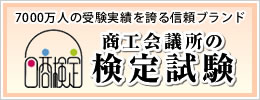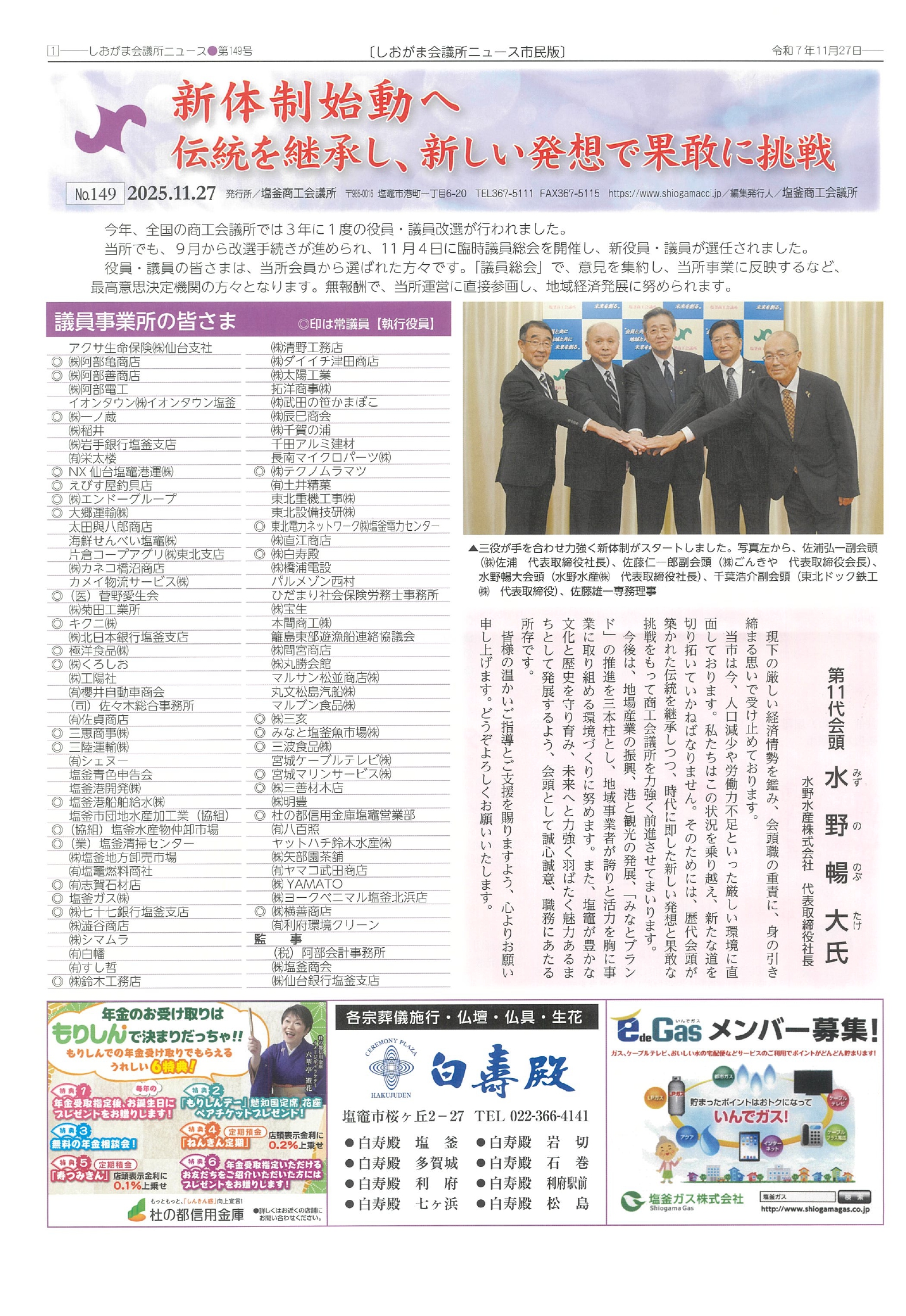おさんこ茶屋(鈴木家)の歴史
鈴木家の初代は江戸時代、この地で寺社建築を手がけていた鈴木喜惣(きそう)右衛門(えもん)という宮大工で、仙台藩主も休泊した西町の老舗菓子舗・越後屋(三井家)の昔の建物や、旭町の東園寺の旧本堂の建築などに関わったという。同家によれば喜惣右衛門は棟梁(とうりょう)で、藩から苗字(みょうじ)帯刀(たいとう)を許されていたともいう。ところで仙台藩はかつて御家騒動の寛文事件によりお取り潰しの危機に直面したが、存続を許された後は幕府に遠慮して、仙台城下での遊郭(ゆうかく)や芸能興業を禁止していた。その代わり塩竈ではそれらを公認したので、御釜神社から西町に至るこの辺りは遊郭街となり、鹽竈神社の参拝を兼ねて遊興に来る人々でおおいに賑わった。
その際、鈴木家の屋敷は芸能興業の会場として使われたという。宮大工であった屋敷は大きく、店を兼ねた住居は道側から土間、奥に向かって十畳、八畳、六畳の続き間になっていたらしい。そこで奥の六畳間を舞台とし、続き間と土間を客席として、芝居・寄席・浪曲・義太夫などが演じられたという。
茶屋は二代目喜惣右衛門の妻が本業の片手間に自宅の軒先を使って始めたものとされ、これが繁昌したので、その後、鹽竈神社の境内にも出店を出すことが許されたという。この茶店を継いだ娘が「さん」といい、その容姿が評判となって店は一層繁昌したので、その名をとって「おさんこ茶屋」と呼ばれるよ
うになったという。
茶店では、団子はもとより飯物や麺類、おでんなどの煮物、酒や肴なども売られ、元朝参りやお祭り、花見の時などは店内は足の踏み場もないほどの混雑ぶりであったという。
現在はおさんから数えて六代目となり、塩竈名物の五色団子を製造販売する老舗として営業を続けている。
令和元年十月 文 斎藤善之(東北学院大学教授)
設置 塩釜商工会議所
○英語(English)
History of the Osanko Teahouse (and Suzuki family)
The first generation of the Suzuki family was Kisoemon Suzuki, a carpenter
for temples and shrines who dealt with the building of Buddhist temples
and Shinto shrines for this land in the Edo era. He was also involved in
the older buildings of the long-standing confectionery shop, Echigoya House
(belonging to the Mitsui family) in Nishi-machi, which accommodated many
feudal lords of the Sendai Domain, as well as the structures which the
former main hall of Toen-ji Temple in Asahi-cho consisted of. According
to the Suzuki family, Kisoemon was appointed the head carpenter and permitted
to adopt a surname and wear a pair of swords from the feudal clan. The
Sendai Domain once faced a crisis, with the possibility of forfeiture,
due to family feud and what is known as the Kanbun incident; however, after
their continuation was allowed, they distanced themselves from the Shogunate
and prohibited running a red light and entertainment district around the
Sendai-jo Castle town. On the other hand, as they gave official approval
of performances in Shiogama, red light district streets were built around
the neighborhood of Okama-jinja Shrine through Nishi-machi which became
packed with people who came both for pleasure as well as worship at the
Shiogama-jinja Shrine.
The Suzuki family mansion is said to have been used as a venue which hosted
entertainment on these occasions. It appears that the carpenter's large
mansion also served as a theater, and later a teahouse consisting of a
dirt floor on the wayside, as well as rooms 10, 8, and 6-tatami mats in
size, connected with one another towards the back. Therefore, they say
that the 6 tatami-mat room in the back was arranged as a stage, and that
the connecting rooms and the dirt floor were made to facilitate the audience,
where they staged performances such as theatrical plays, Yose (storytelling
theater), Rokyoku (a type of narrative singing often to the tune of a shamisen),
Gidayu (another type of narrative singing often used in puppet theater),
as well as other varieties of performance. The teahouse at this location
was started by the wife of Kisoemon Suzuki the Second (nidaime) in her
spare time between her main profession, using the eaves of the house to
make the tea. As this business prospered, they are said to have been allowed
to open a shop in the precincts of the Shiogama-jinja Shrine afterwards.
As the daughter who succeeded this tea house was named “San”, and the shop
further prospered because of her good figure, it is said that the teahouse
came to be known as the “Osanko Teahouse”, named after her.
In the teahouse, a variety of foods are offered, including meals with
rice, noodles, dango, stewed dishes such as oden among others, alcohol
and side-dishes, and more. It is said that during times such as New Year's
shrine visits, festivals and cherry blossom viewing the shop was so crowded
with people that there was not even room to stand in the shop.
The long-established shop is now managed by the 6th generation down from
Osan and continues to produce and sell the famous five-colored dango which
are a Shiogama specialty.
October of the 1st year of Reiwa (2019)
Article by Yoshiyuki Saito (professor at Tohoku Gakuin University)
Organizer: Shiogama Chamber of Commerce and Industry
○中国語(中文)
OSANKO茶屋(鈴木家)的歷史
鈴木家第一代是江戶時代從事當地寺社建築建設的鈴木喜惣右衛門宮大工(日本傳統專門修築神社仏閣木工匠師),其曾参与修建仙台藩主下榻過的西町老鋪菓子舖越後屋(三井家)的舊建築、旭町東園寺舊本堂的建築等等。据本家人說,喜惣右衛門為工頭,擁有仙台藩賦予「苗字帶刀」(“苗字”即擁有姓名權,而“帶刀”則是可佩戴雙刀)的特權。但是,仙台藩因受御家騷動寬文事件的影響曾一度面臨崩潰改易的危險。平安無事後為對幕府謹慎行事,禁止了仙台城下的遊郭(妓院)和藝能興業,但允許鹽竈取代仙台從事這些事業。因而從御釜神社至西町這一帶成爲遊郭街,人們參拜鹽竈神社之際順便來這裏游樂,熱鬧非凡。
據説,當時鈴木家的宅地曾作爲藝能興業會場使用。宮大工的宅地非常寬敞,兼有店鋪的宅邸從靠街一側起首先是土間,往裏數有十個榻榻米、八個榻榻米和六個榻榻米的「續間」(相互連通)。最裏面六個榻榻米的房間作爲舞台,其他兩個續間和土間作爲客席,在此上演小劇場、寄席、浪曲和義大夫等多彩多姿的藝能節目。
茶屋,據説是第二代喜惣右衛門的妻子在本職工作之餘利用自宅屋前開始經營的。伴隨著生意不斷興隆,又被允許在鹽竈神社域内開店。之後,其女「SAN」繼承了該茶店,她美麗動人招來更多顧客,生意越發興隆,人們就取其名,稱茶店為「OSANKO茶屋」。
茶店裏不僅出售糰子,而且還有米飯類和麵類、關東煮等煮物以及酒和菜餚等等,在新年初次參拜、祭祀活動和賞花季節等期間,店内連落脚的地方都沒有,生意十分興隆。
現在,從「SAN」數起,OSANKO茶屋已是第六代,作爲製作販賣鹽竈名小吃五色糰子的老鋪代代相傳,亙古流轉。
令和元年(2019年)10月 文 齋藤善之(東北學院大學教授)
設置 鹽釜商工會議所
○韓国語(한국어)
오산코 찻집(스즈키 가문)의 역사
스즈키(鈴木) 가문의 창시자는 에도 시대(1603-1867)에 이 지역에서 절과 신사 건축을 다룬 스즈키 기소 우에몬(鈴木 喜惣
右衛門)이라는 궁목수였다. 그는 센다이번 영주가 묵은 니시마치의 유서 깊은 노포 과자점 에치고야의 옛 건물, 아사히초에 자리하는
도엔지 절의 구 본당 건축 등에 종사하였다. 스즈키 가문에 의하면 기소 우에몬은 번으로부터 묘지타이토(名字帯刀, 에도 시대에 (공이
있는) 평민에게 특별히 허용해서 성씨를 쓰고 칼을 차게 한 일)를 허락받은 도편수였다. 당시, 센다이번은 일찍이 ‘간분 사건’이라는
내분으로 가문 존속의 위기에 직면, 존속을 허락받은 후 에도 바쿠후에 대해 자중하는 모습을 보이고자 센다이 성읍에서의 유곽(공창),
예능 산업을 금지하였다. 대신 시오가마에서 그것들을 공인하자 오카마 신사에서 니시마치에 이르는 이 일대에 유곽 거리가 형성되었고,
시오가마 신사 참배를 겸해 유흥을 목적으로 방문하는 사람들로 많은 활기를 이루었다.
당시, 궁목수의 저택은 집이 매우 컸고, 스즈키 가문의 저택은 예능 산업의 장으로서 사용되었다. 가게를 겸한 주거는 저택 앞길부터
안쪽으로 토방, 10다다미*, 8다다미, 6다다미 순서로 방이 죽 이어진 구조였는데, 제일 끝의 6다다미 방을 무대로 10다다미,
8다다미, 토방을 객석으로 사용해 연극·요세(寄席)*·로쿄쿠(浪曲)*·기다유(義太夫)* 등이 공연되었다.
제2대 기소 우에몬의 아내가 본업 틈에 자택의 처마 끝을 이용해 찻집을 시작하자 장사가 제법 잘 되었다. 그 후, 시오가마 신사의
경내에 개점이 허락되었는데, 이 찻집을 이어받은 딸 이름이 바로 ‘산’이었다. 그녀의 용모가 수려하다는 소문이 차차 넓게 퍼지면서
장사가 더 잘되자, 그녀의 이름을 따서 <오산코 찻집>이라 불리게 되었다.
다다미* 일본 고유의 전통 바닥재
요세(寄席)* 일본의 전통 연예 공연장
로쿄쿠(浪曲)* 전통 현악기 샤미센의 반주에 맞추어 노래와 말로 이야기를 읊는 예능.
기다유(義太夫)* 에도 시대 전기, 오사카의 다케모토 기다유(竹本義太夫)가 시작한 조루리의 일종. 조루리는 샤미센 반주에 맞추어
이야기를 읊는 음곡, 극장음악.
찻집에서는 당고(경단과 비슷한 일본 음식)를 비롯해 밥류, 면류, 오뎅 등의 조림 요리, 술이나 술안주 등도 팔았다. 찻집은 새해
아침 참배, 축제, 꽃놀이 등 계절에는 발 디딜 틈이 없을 정도로 붐볐다.
현재, 오산 씨부터 이어진 찻집은 제6대 주인이 계승해 시오가마 명물 오색 당고를 제조 판매하는 유서 깊은 노포로서 영업하고 있다.
2019년 10월 글 사이토 요시유키(斎藤 善之, 도호쿠 학원대학 교수)
설치 시오가마 상공회의소
















